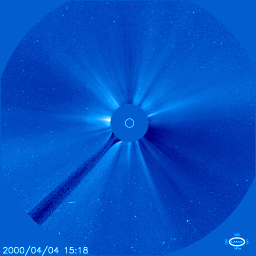Geomagnetic storms are associated with solar flares and coronal mass ejections (CME). The geomagnetic storm which happened last week had some effect on communications in China but obviously it could have been a lot worse. The recent geomagnetic storm was due to a Class X2.2 solar flare but in 1859 a real doozy happened, so powerful it knocked out telegraph wires and caused auroras so powerful at the poles people claimed they could read using the light. Since the sun is emerging from a relatively quiet period in its 11-year cycle we could see more severe geomagnetic storms as well.
Southwest Research Institute defines a coronal mass ejection as a massive burst of solar wind, other light isotope plasma, and magnetic fields rising above the solar corona and this one sent charged plasma particles toward Earth at about 560 miles per second.
Some geomagnetic storms are recurrent and happen every 27 days, corresponding to the Sun's rotation period but others occur more frequently near solar maximum and have both the interplanetary shock wave and the CME that drives it.
So what does it really mean to have a geomagnetic storm? Basically, the magnetosphere is a region of space around Earth controlled by our planet's magnetic field and it forms a shield that normally protects Earth from solar wind storms. A strong gust of solar wind can compress the magnetosphere and trigger a geomagnetic storm.

This sequence shows a coronal mass ejection moving from the Sun after the onset of a solar flare on April 4, 2000. The solid colored circle in the middle is the occulting disk of the Solar and Heliospheric Observatory's C3 coronagraph. It blocks out the intense light of the Sun so that the tenuous corona is visible. The C3 coronagraph is able to observe the Sun's corona between 3.5 to 30 solar radii. Credit: NASA
As the material from a CME flows away from the Sun, it piles up against slower-moving gas that has been ejected earlier, which produces a sharp, dense shock front. The shock wave from the eruption on in the graphic above traveled two days through interplanetary space before reaching Earth. When it arrived it triggered aurora so bright that they could be seen from a brightly lit parking lot in Yonkers, New York.
Simulation of a CME impact on Earth's magnetosphere. With the sun off screen to the left, the earth's magnetosphere is visualized as a series of translucent blue shells that depict the magnetic fields at 60, 75, and 85 degrees from the equator. The electrically charged CME travels through the magnetosphere in roughly one hour, compressing the magnetic field lines and inducing a buildup in the earth's auroras. After the CME passes, the field lines quickly return to their original configuration and the auroras return to their pre-impact energy levels. For visual clarity, this simulation shows the auroral increase peaking well after the CME passes.






Comments